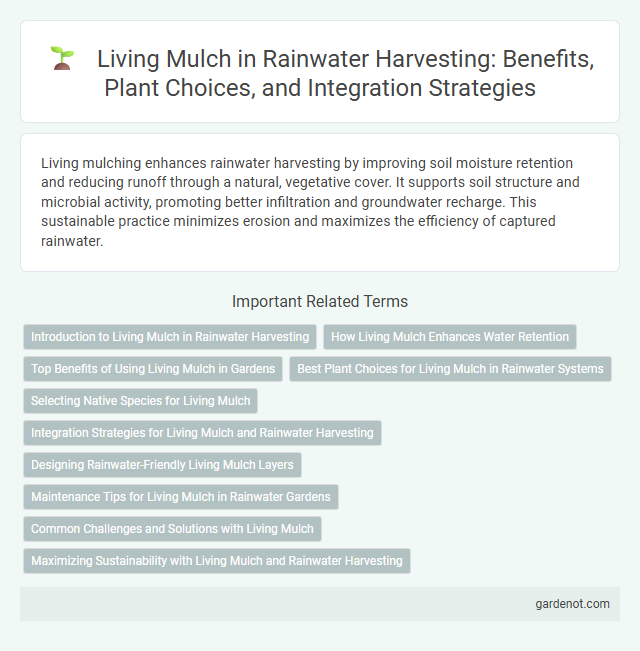Living mulching enhances rainwater harvesting by improving soil moisture retention and reducing runoff through a natural, vegetative cover. It supports soil structure and microbial activity, promoting better infiltration and groundwater recharge. This sustainable practice minimizes erosion and maximizes the efficiency of captured rainwater.
Introduction to Living Mulch in Rainwater Harvesting
Living mulch involves planting ground-cover crops that protect soil surfaces and enhance water retention in rainwater harvesting systems. These cover crops reduce soil erosion, increase infiltration rates, and improve moisture conservation, creating optimal conditions for rainwater capture. Integrating living mulch supports sustainable water management by maintaining soil health and maximizing rainwater utilization in agricultural and landscaping applications.
How Living Mulch Enhances Water Retention
Living mulch improves rainwater harvesting by increasing soil permeability and reducing surface runoff, allowing more water to infiltrate the soil. The dense root systems of living mulch enhance soil structure and organic matter content, which boosts the soil's ability to retain moisture. By shading the ground, living mulch also reduces evaporation, helping maintain optimal soil moisture levels for plant growth.
Top Benefits of Using Living Mulch in Gardens
Living mulching enhances soil moisture retention by reducing evaporation, which optimizes rainwater harvesting in gardens. It suppresses weeds, minimizing competition for water and nutrients while improving soil structure through organic matter contribution. This sustainable practice promotes biodiversity and supports beneficial insects, fostering a healthier garden ecosystem.
Best Plant Choices for Living Mulch in Rainwater Systems
Best plant choices for living mulch in rainwater harvesting systems include drought-tolerant species such as clover, creeping thyme, and native grasses, which enhance soil moisture retention and prevent erosion. Deep-rooted plants like comfrey and yarrow improve soil structure while maximizing rainwater infiltration. Selecting nitrogen-fixing plants like lupines boosts soil fertility, supporting overall system health and sustainability.
Selecting Native Species for Living Mulch
Selecting native species for living mulch is essential in rainwater harvesting as these plants naturally adapt to local soil and climate conditions, enhancing water retention and reducing erosion. Native groundcovers like clover, creeping thyme, or native grasses improve soil permeability and minimize runoff, maximizing the effectiveness of rainwater absorption. Utilizing drought-resistant native species ensures sustainable moisture conservation and supports local biodiversity within rainwater harvesting systems.
Integration Strategies for Living Mulch and Rainwater Harvesting
Integrating living mulch with rainwater harvesting enhances soil moisture retention by creating a protective ground cover that reduces evaporation and runoff. Strategic placement of drought-tolerant plants as living mulch around catchment areas maximizes water infiltration and nutrient cycling. Combining contour-based water catchment systems with living mulch layers promotes sustainable water management and soil health in agricultural landscapes.
Designing Rainwater-Friendly Living Mulch Layers
Designing rainwater-friendly living mulch layers involves selecting deep-rooted, drought-tolerant plant species that enhance soil infiltration and reduce surface runoff. Incorporating a mix of ground covers, grasses, and legumes helps create a permeable mulch layer that promotes water retention while preventing erosion. Proper arrangement and density optimize rainwater absorption, contributing to sustainable water management in rainwater harvesting systems.
Maintenance Tips for Living Mulch in Rainwater Gardens
Maintaining living mulch in rainwater gardens involves regular trimming to prevent overgrowth that could impede water absorption and flow. Monitoring soil moisture and ensuring the mulch remains healthy and disease-free promotes optimal root development and enhances rainwater infiltration. Periodic removal of weeds and replenishment of organic mulch layers supports soil structure and nutrient retention, improving the overall efficiency of rainwater harvesting systems.
Common Challenges and Solutions with Living Mulch
Living mulching often faces challenges such as competition for water and nutrients between the main crops and the mulch plants, potential pest habitat creation, and difficulties in crop management due to dense vegetation. Solutions include selecting compatible mulch species with low water and nutrient demands, implementing strategic planting patterns to minimize competition, and using integrated pest management to control pest populations effectively. Regular monitoring and adaptive management practices ensure that living mulch enhances soil moisture retention without compromising crop yield in rainwater harvesting systems.
Maximizing Sustainability with Living Mulch and Rainwater Harvesting
Living mulching enhances rainwater harvesting by improving soil moisture retention and reducing surface runoff, promoting sustainable water use in agricultural practices. The dense cover of living mulch plants stabilizes soil structure and minimizes erosion, while simultaneously increasing infiltration rates during rainfall events. Integrating living mulch with rainwater harvesting systems maximizes ecosystem resilience and supports long-term soil health through natural water conservation methods.
Living mulching Infographic

 gardenot.com
gardenot.com